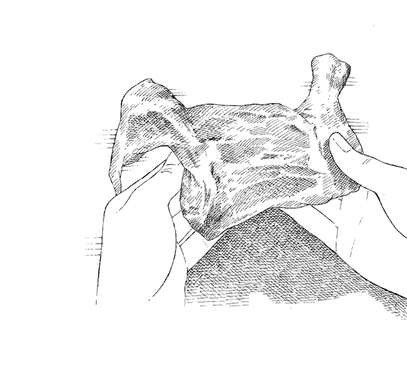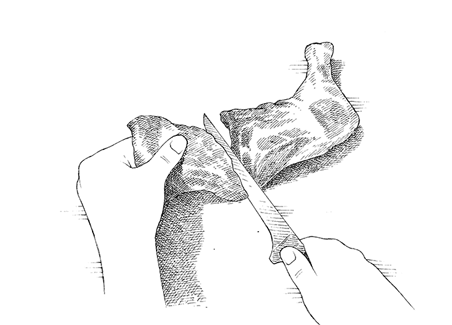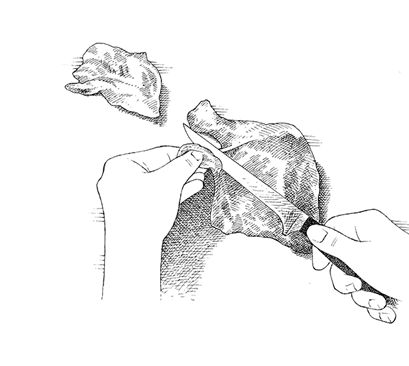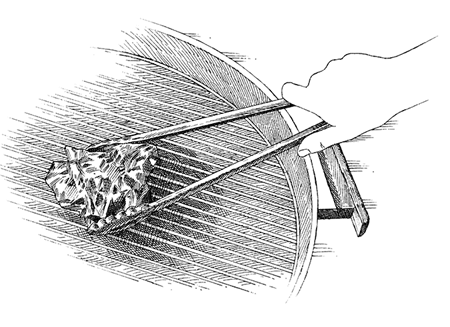The Cook's Illustrated Cookbook (219 page)
Read The Cook's Illustrated Cookbook Online
Authors: The Editors at America's Test Kitchen
Tags: #Cooking


1.
Carefully grasp leg and bend backbone section to pop joint.

2.
Using sharp boning knife, cut backbone section from leg.

3.
Trim away any large pockets of fat.
![]() WHY THIS RECIPE WORKS
WHY THIS RECIPE WORKS
Made-from-scratch barbecued pulled chicken sandwiches often consist of boneless chicken breasts and bottled barbecue sauce. The result is a sandwich with no smoke, tough meat, and artificial flavor. We wanted a recipe that gave us tender, smoky chicken meat in a tangy, sweet sauce. We chose whole chicken legs for great flavor, low cost, and resistance to overcooking. The legs cooked gently but thoroughly over indirect heat, absorbing plenty of smoke flavor along the way. Cooking the chicken to a higher-than-usual temperature also dissolved connective tissue and rendered more fat, making the meat tender and less greasy. Once the chicken finished cooking, we hand-shredded half and machine-processed the other half for a texture similar to pulled pork. The chicken then just had to be combined with a tangy barbecue sauce to become truly bun-worthy.
See “IMPROVISED GRILL BRUSH” illustration that follows recipe.
SERVES 6 TO 8
Chicken leg quarters consist of drumsticks attached to thighs; often also attached are backbone sections that must be trimmed away. Two medium wood chunks, soaked in water for 1 hour, can be substituted for the wood chip packet on a charcoal grill. Serve the pulled chicken on hamburger rolls or sandwich bread, with pickles and coleslaw.
CHICKEN
2 | cups wood chips, soaked in water for 15 minutes and drained |
1 | (16 by 12-inch) disposable aluminum roasting pan (if using charcoal) |
1 | tablespoon vegetable oil |
8 | (14-ounce) chicken leg quarters, trimmed |
Salt and pepper |
SAUCE
1 | large onion, peeled and quartered |
¹⁄ | cup water |
1¹⁄ | cups ketchup |
1¹⁄ | cups apple cider |
¹⁄ | cup molasses |
¹⁄ | cup apple cider vinegar |
3 | tablespoons Worcestershire sauce |
3 | tablespoons Dijon mustard |
¹⁄ | teaspoon pepper |
1 | tablespoon vegetable oil |
1¹⁄ | tablespoons chili powder |
2 | garlic cloves, minced |
¹⁄ | teaspoon cayenne pepper |
Hot sauce |
1. FOR THE CHICKEN:
Using large piece of heavy-duty aluminum foil, wrap soaked chips in foil packet and cut several vent holes in top.
2A. FOR A CHARCOAL GRILL:
Open bottom vent halfway and place roasting pan in center of grill. Light large chimney starter three-quarters filled with charcoal briquettes (4¹⁄
2
quarts). When top coals are partially covered with ash, pour into 2 even piles on either side of roasting pan. Place wood chip packet on 1 pile of coals. Set cooking grate in place, cover, and open lid vent halfway. Heat grill until hot and wood chips are smoking, about 5 minutes.
2B. FOR A GAS GRILL:
Place wood chip packet directly on primary burner. Turn all burners to high, cover, and heat grill until hot and wood chips are smoking, about 15 minutes. Turn all burners to medium. (Adjust burners as needed during cooking to maintain grill temperature between 250 and 300 degrees.)
3.
Clean and oil cooking grate. Pat chicken dry with paper towels and season with salt and pepper. Place chicken in single layer on center of grill (over roasting pan if using charcoal), skin side up, or evenly over grill (if using gas). Cover (position lid vent over meat if using charcoal) and cook until chicken registers 185 degrees, 1 to 1¹⁄
2
hours, rotating the chicken pieces halfway through cooking. Transfer chicken to carving board, tent loosely with foil, and let rest until cool enough to handle.
4. FOR THE SAUCE:
Meanwhile, process onion and water in food processor until mixture resembles slush, about 30 seconds. Pass through fine-mesh strainer into liquid measuring cup, pressing on solids with rubber spatula (you should have ³⁄
4
cup strained onion juice). Discard solids in strainer.
5.
Whisk onion juice, ketchup, cider, molasses, 3 tablespoons vinegar, Worcestershire, mustard, and ¹⁄
2
teaspoon pepper together in bowl. Heat oil in large saucepan over medium heat until shimmering. Stir in chili powder, garlic, and cayenne and cook until fragrant, about 30 seconds. Stir in ketchup mixture, bring to simmer, and cook over medium-low heat until slightly thickened, about 15 minutes (you should have about 4 cups of sauce). Transfer 2 cups sauce to serving bowl; leave remaining sauce in saucepan.
6. TO SERVE:
Remove and discard skin from chicken legs. Using your fingers, pull meat off bones, separating larger pieces (which should fall off bones easily) from smaller, drier pieces into 2 equal piles.
7.
Pulse smaller chicken pieces in food processor until just coarsely chopped, 3 to 4 pulses, stirring chicken with rubber spatula after each pulse. Add chopped chicken to sauce in saucepan. Using your fingers or 2 forks, pull larger chicken pieces into long shreds and add to saucepan. Stir in remaining 1 tablespoon cider vinegar, cover, and heat chicken over medium-low heat, stirring occasionally, until heated through, about 10 minutes. Add hot sauce to taste and serve, passing remaining sauce separately.
This recipe serves 10 to 12. This technique works well on a charcoal grill but not so well on a gas grill. If your gas grill is large and can accommodate more than 8 legs, follow the master recipe, adding as many legs as will comfortably fit in a single layer.
Increase amount of charcoal briquettes to 6 quarts. Use 12 chicken legs and slot them into V-shaped roasting rack set on top of cooking grate over disposable aluminum pan. Increase cooking time in step 3 to 1¹⁄
2
to 1³⁄
4
hours. In step 5, remove only 1 cup of sauce from saucepan. In step 7, pulse chicken in food processor in 2 batches.

Food that is being grilled is much less likely to stick to a clean grate. We recommend cleaning the hot grate with a grill brush. But if you don’t have one handy, a brush can be improvised with a pair of tongs and a crumpled wad of aluminum foil.
![]() WHY THIS RECIPE WORKS
WHY THIS RECIPE WORKS
Smoked chicken needs to be cooked for a long time to be truly imbued with smoke flavor, but the breast meat dries out easily, and without high heat it’s difficult to get the skin to crisp. We wanted a recipe for perfectly cooked meat with a pervasive smoky flavor and crisp mahogany skin. First, a salt and sugar brine guaranteed moist, well-seasoned meat. We found that chicken parts were easier and better than whole chickens; the breasts could cook evenly on the coolest part of the grill and more of the bird was exposed to the smoke and heat, adding flavor and rendering more fat from the skin. To keep the skin moist, we brushed it with oil and added a pan of water to the grill. One wood chip packet burned too quickly to permeate the meat, so we added a second, which produced the ideal amount of smoke for meat subtly flavored all the way through. In the end, we had wonderfully smoky, moist chicken with glossy skin after only 90 minutes on the grill.
